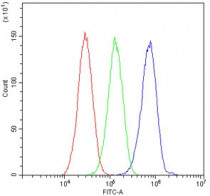ARG58202
anti-PERK antibody
anti-PERK antibody for Flow cytometry,Western blot and Human,Mouse,Rat
Overview
| Product Description | Rabbit Polyclonal antibody recognizes PERK |
|---|---|
| Tested Reactivity | Hu, Ms, Rat |
| Tested Application | FACS, WB |
| Host | Rabbit |
| Clonality | Polyclonal |
| Isotype | IgG |
| Target Name | PERK |
| Antigen Species | Human |
| Immunogen | Recombinant protein corresponding to R222-Q334 of Human PERK. |
| Conjugation | Un-conjugated |
| Alternate Names | PRKR-like endoplasmic reticulum kinase; PERK; HsPEK; Eukaryotic translation initiation factor 2-alpha kinase 3; Pancreatic eIF2-alpha kinase; WRS; PEK; EC 2.7.11.1 |
Application Instructions
| Application Suggestion |
|
||||||
|---|---|---|---|---|---|---|---|
| Application Note | * The dilutions indicate recommended starting dilutions and the optimal dilutions or concentrations should be determined by the scientist. | ||||||
| Observed Size | ~ 140 kDa |
Properties
| Form | Liquid |
|---|---|
| Purification | Affinity purification with immunogen. |
| Buffer | PBS, 0.025% Sodium azide and 2% Trehalose. |
| Preservative | 0.025% Sodium azide |
| Stabilizer | 2% Trehalose |
| Concentration | 0.5 mg/ml |
| Storage Instruction | For continuous use, store undiluted antibody at 2-8°C for up to a week. For long-term storage, aliquot and store at -20°C or below. Storage in frost free freezers is not recommended. Avoid repeated freeze/thaw cycles. Suggest spin the vial prior to opening. The antibody solution should be gently mixed before use. |
| Note | For laboratory research only, not for drug, diagnostic or other use. |
Bioinformation
| Database Links |
Swiss-port # Q9NZJ5 Human Eukaryotic translation initiation factor 2-alpha kinase 3 Swiss-port # Q9Z1Z1 Rat Eukaryotic translation initiation factor 2-alpha kinase 3 |
|---|---|
| Gene Symbol | EIF2AK3 |
| Gene Full Name | eukaryotic translation initiation factor 2-alpha kinase 3 |
| Background | The protein encoded by this gene phosphorylates the alpha subunit of eukaryotic translation-initiation factor 2, leading to its inactivation, and thus to a rapid reduction of translational initiation and repression of global protein synthesis. This protein is thought to modulate mitochondrial function. It is a type I membrane protein located in the endoplasmic reticulum (ER), where it is induced by ER stress caused by malfolded proteins. Mutations in this gene are associated with Wolcott-Rallison syndrome. [provided by RefSeq, Sep 2015] |
| Function | Phosphorylates the alpha subunit of eukaryotic translation-initiation factor 2 (EIF2), leading to its inactivation and thus to a rapid reduction of translational initiation and repression of global protein synthesis. Serves as a critical effector of unfolded protein response (UPR)-induced G1 growth arrest due to the loss of cyclin-D1 (CCND1). Involved in control of mitochondrial morphology and function (By similarity). [UniProt] |
| Calculated MW | 125 kDa |
| PTM | Oligomerization of the N-terminal ER luminal domain by ER stress promotes PERK trans-autophosphorylation of the C-terminal cytoplasmic kinase domain at multiple residues including Thr-982 on the kinase activation loop (By similarity). Autophosphorylated. Phosphorylated at Tyr-619 following endoplasmic reticulum stress, leading to activate its tyrosine-protein kinase activity. Dephosphorylated by PTPN1/TP1B, leading to inactivate its enzyme activity. N-glycosylated. ADP-ribosylated by PARP16 upon ER stress, which increases kinase activity. [UniProt] |
Images (2) Click the Picture to Zoom In
-
ARG58202 anti-PERK antibody WB image
Western blot: 1) HeLa, 2) COLO320, 3) A549, 4) SK-OV-3, 5) A431, 6) Rat brain and 7) Mouse brain lysates stained with ARG58202 anti-PERK antibody at 0.5 µg/ml dilution.
-
ARG58202 anti-PERK antibody FACS image
Flow Cytometry: HepG2 cells were blocked with goat sera and stained with ARG58202 anti-PERK antibody at 1 µg/10^6 cells (blue); Cells alone (red); Isotype control (green).







